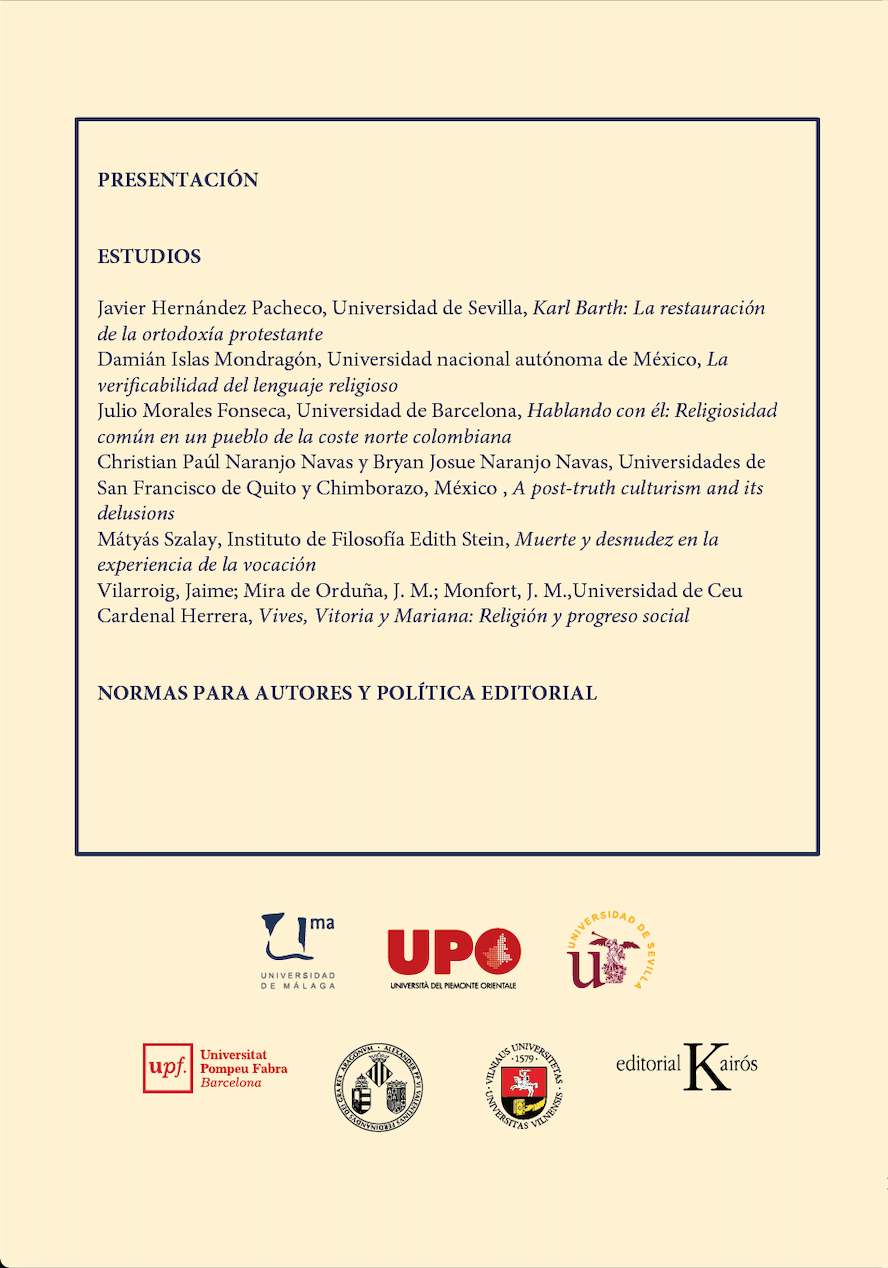A POST-TRUTH CULTURISM AND ITS DELUSIONS
DOI:
https://doi.org/10.24310/Raphisa.2019.v0i5.5251Keywords:
POST-TRUTH, POSTMODERNISM, CULTURISM, ANCESTRAL WISDOMAbstract
In a postmodern culturism, everything is relative, in this way, nothing can be affirmed as absolute truth. Taking into account that culturism is the belief that some cultures are superior than others, this essay proposes the idea that a postmodern culturism is the belief, superior to others, that all cultures are to be revered. Within a postmodern culturism, the essay proposes the analysis of three common arguments through a specific epistemological perspective, rationalism: empirical data and the primacy of reason. The analyzed arguments are: first, all cultures ought to be equally revered; second, western logic is different to the ancestral logic; third, all ancestral cultures have wisdom. The article concludes that these arguments do not withstand the rational analysis.Downloads
Metrics
References
Arellano, Angélica (2003) Maya Mathematics and Science. Recuperado el 10 de July de 2018, de http://citeseerx.ist.psu.edu/viewdoc/download?doi=10.1.1.165.6984&rep=rep1&type=pdf
Asociación Mujeres entre Mundos (2016) Guía para la conciencia sobre mutilaciones genitales femeninas. Andalucía: Junta de Andalucía Consejería de Igualdad y Políticas Sociales.
Blake, Fred (1994) Foot-Binding in Neo-Confucian China and the Appropriation of Female Labor. Journal of Women in Culture and Society, vol. 19(N. 31), 676-712.
Cooke, Roger (2012) The History of Mathematics: A Brief Course. (U. o. Vermont, Ed.) Burlington, VT: John Wiley & Sons.
D' Altroy, Terence (2003) The Incas (Peoples of America). Oxford: Wiley Blackwell.
Encyclopedia Britannica. (2018). Encyclopædia Britannica. Recuperado el 10 de July de 2018, de Laws of thought: https://www.britannica.com/topic/laws-of-thought
Fink, Rita (2008) Inca Shadow Casting Observations in Cuzco. Journal for the History of Astronomy, vol. 39(N. 3), 357-361.
Gu, Yaodong, Mei, Q., Fernandez, J., Li, J., Ren, X., & Feng, N. (2015) Foot Loading Characteristics of Chinese Bound Feet Women: A Comparative Analysis. PLoS ONE, Vol. 10(N. 4), 1-9.
Huapaya, Enrique, & Salas, César (febrero de 2008) Uso de las Ideas Matemáticas y Científicas de los Incas, en la Enseñanza- Aprendizaje de la Geometría. Revista Latinoamericnaa de Etnomatemática(N. 1), 4-12.
Human Rights Watch. «North Korea Country Summary». Consultado en febrero 10, 2018. https://www.hrw.org/world-report/2017/country-chapters/north-korea
Ifrah, George (1998) The Universal History of Numbers: From Prehistory to the Invention of the Computer. Great Britain: The Harvill Press Ltd.
Keyes, Ralph (2004) The Post-Truth Era: Dishonesty and Deception in Contemporary Life. New York, EE.UU.: St. Martin Press.
Knauft, Bruce (1985) Ritual form and permutation in New Guinea: implications of symbolic process for socio-political evolution. American Anthropological Association, 321-340.
Knierim, Thomas (2007) Introduction to Buddhism. Recuperado el 01 de 08 de 2018, de http://www.goabroad.net/users/resourcefiles/2007/May/JNovember/admingroup/14665f5912a1941181087121.pdf
Martín Rubio, María del Carmén. (2009). La cosmovisión religiosa andina y el rito de la Capacocha. Investigaciones sociales, Vol. 13(N. 23), 187-201.
Mill, John Stuart (2001 [1863]) Utilitarianism. Ontario: Batoche Books.
Ortiz García, Elena (2012) Los incas y el Sol: métodos de observación solar y calendario incaicos. Revista española de Antropología Americana, vol 42(N. 1), 127/143.
Oxford University Press. (enero de 2017). Oxford living dictionaries. Recuperado el 2018, de https://en.oxforddictionaries.com/word-of-the-year/word-of-the-year-2016
Reinhard, Johan & Ceruti, Constanza (2005) Sacred mountains, ceremonial sites, and human sacrifice among the Incas. Archaeoastronomy, 19, 1-43.
Restivo, Sal (1992) Mathematics in Society and History. Sociological Inquiries. Dordrecht: Springer-Science+Business Media, B.V.
Saunders, Ben (2010) Democracy, Political Equality, and Majority Rule. Ethics, 148-177.
Schabas, William (2000) Islam and the Death Penalty. William & Mary bill of Rights Journal, Vol. 9(N. 1), 223-236.
Shakiban, Cheri & Hennessey, Michael (2011). Mathematics and architecture of the Incas in Peru. St. Paul: American Society for Engineering Education.
Vitry, Christian (2008) Los espacios rituales en las montañas donde los inkas practicaron sacrificios humanos. En C. Terra, & R. Andrade, Paisagens Culturais. Contrastes sul-americanos (págs. 47-65). Rio de Janerio: Universidade Federal do Rio de Janeiro.
White Stewart, Mary (2014) Ordinary Violence: Everyday Assaults against Women Worldwide. Santa Barbara: Praeger.
World Health Organization. (2013). Comprender y abordar la violencia contra las mujeres. Mutilización genital femenina. Organización anamericana de la Salud, Washington D.C.
Downloads
Published
How to Cite
Issue
Section
License
License permitted by the journal: Public Domain. Authors retain the copyright and full publishing rights without restrictions.






